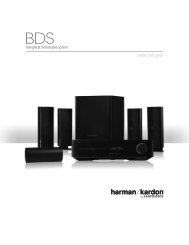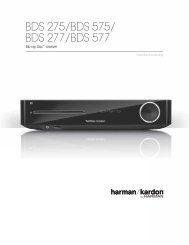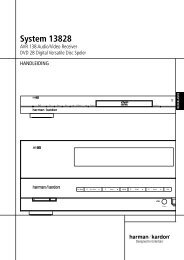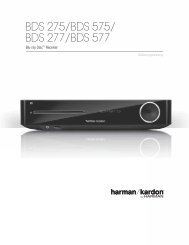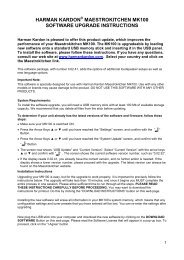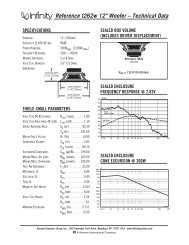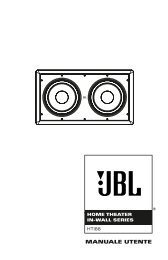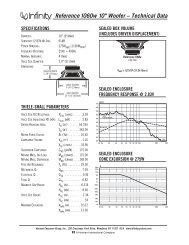Create successful ePaper yourself
Turn your PDF publications into a flip-book with our unique Google optimized e-Paper software.
• Use the up cursor/down cursor buttons to navigate through the menu list When<br />
an item is highlighted, its icon will turn bright and its name will become larger<br />
• To select a highlighted item, press the Enter button The screen will change<br />
depending on your selection<br />
• To display choices for the current screen (if available), press the right cursor<br />
button<br />
• To return to the previous screen, press the left cursor button<br />
Settings Menu<br />
Before using the <strong>HS</strong> <strong>280</strong>/<strong>HS</strong> <strong>210</strong>, you will need to set the receiver’s various<br />
video, audio and other functions Scroll down the Activity menu until Settings is<br />
highlighted, then select it The Settings menu will appear You will use the various<br />
Settings menu items to configure your <strong>HS</strong> <strong>280</strong>/<strong>HS</strong> <strong>210</strong> to work as you want it to with<br />
your TV and other components<br />
Video Settings<br />
Aspect ratio: Select the aspect ratio of your TV or video display (16:9 or 4:3)<br />
TV standard: Select your TV or video display’s TV standard (automatic or PAL)<br />
If you have an NTSC or multi-standard TV, use the Automatic setting NOTE: If you<br />
make an incorrect setting in this menu, the signal to your TV will be temporarily lost,<br />
but you can change to the correct setting by using the <strong>HS</strong> <strong>280</strong>/<strong>HS</strong> <strong>210</strong>’s front-panel<br />
Information Display<br />
Output: Select which video connection (HDMI or analog) you are using between the<br />
<strong>HS</strong> <strong>280</strong>/<strong>HS</strong> <strong>210</strong> and your TV NOTE: The <strong>HS</strong> <strong>280</strong>/<strong>HS</strong> <strong>210</strong> does not output both HDMI and<br />
analog video simultaneously<br />
Resolution (HDMI only): Select the highest resolution your TV can handle (480p<br />
(NTSC), 576p (PAL), 720p, 1080i or 1080p) NOTE: This setting is available only if you<br />
selected HDMI as the output type<br />
SCART (analog only): Select the type of video output that your TV will receive<br />
via the SCART cable (S-Video or composite – CVBS – video) NOTE: This setting is<br />
available only if you selected Analog as the output type<br />
19<br />
Audio Settings<br />
Bass, Treble: Increases or decreases the level of bass (low frequencies) or treble<br />
(high frequencies) You can select from –10dB to +10dB in 1dB increments<br />
Subwoofer: Increases or decreases the subwoofer volume You can select from<br />
–10dB to +10dB in 1dB increments<br />
Dynamic range: This setting brings the loud and quiet parts of a movie or music<br />
closer to the same volume This setting lets you turn up the volume so the quiet parts<br />
are audible but the loud parts won't disturb others NOTE: This feature works only<br />
with Dolby Digital programs that have been specially encoded Three settings are<br />
available:<br />
• Min: Does not change the original playback You should use it when the volume<br />
setting in the listening room may be as loud as you desire<br />
• Half: Applies a moderate amount of compression so that louder passages are a<br />
little bit quieter<br />
• Max: Applies more compression so that louder passages are much quieter<br />
Delay: This setting indicates the amount of delay of the audio output relative to the<br />
video output, which eliminates the “out-of-sync” quality that sometimes occurs when<br />
the video source component or the video display processes a video signal The default<br />
setting of 90ms (90 milliseconds) should be correct for most programs However, if<br />
you wish to improve synchronization for a particular program, you can change the<br />
setting to anywhere between 0ms (no delay) and 150ms, in 10ms increments<br />
HDMI Audio to TV: This setting turns the HDMI audio output to your TV on and<br />
off We recommend turning this function off, so you can take full advantage of the<br />
superior audio capability of your <strong>HS</strong> <strong>280</strong>/<strong>HS</strong> <strong>210</strong> system’s receiver and speakers<br />
TV audio input: Set this function to the input to which you have connected your TV’s<br />
audio output When you press the remote’s TV button, TV will become the active audio<br />
input and you can use the remote to control your TV See Connecting Audio Sources,<br />
Line 1/Line 2 In, on page 16<br />
NOTE: If you’ve connected the TV to the <strong>HS</strong> <strong>280</strong>/<strong>HS</strong> <strong>210</strong> using the SCART cable, set this<br />
function to SCART Whenever the TV is turned on, it will send a signal to the <strong>HS</strong> <strong>280</strong>/<br />
<strong>HS</strong> <strong>210</strong>, which will then automatically switch to the SCART input<br />
ENGLISH



